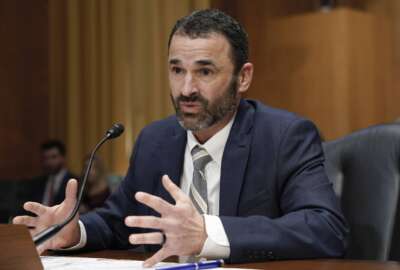Hubbard Radio Washington DC, LLC. All rights reserved. This website is not intended for users located within the European Economic Area.
On Air: Federal News Network
Trending:
DHS surfing the retirement wave, turns focus to leadership, morale
Catherine Emerson, the agency's chief human capital officer, said the annual turnover rate is only 1.35 percent for its 240,000 employees. She said ne...
wfedstaff | April 17, 2015 4:09 pm
The Homeland Security Department hasn’t experienced the retirement wave or had to offer buyouts or early retirements to employees like many other agencies. In fact, it experiences an annual turnover rate of only 1.35 percent for its 240,000 employees.
Catherine Emerson, DHS’s chief human capital officer, said the bigger challenge instead is ensuring the agency’s current employees have the skills to meet existing and future needs.
“We got our components together and we have been examining skill set needs and mission critical occupation needs,” Emerson said Tuesday during an exclusive interview on In Depth with Francis Rose as part of Federal News Radio’s Agency of the Month series. “We’ve gotten our components together sharing needs, sharing best practices, sharing what is occurring in the agencies and looking at what skill set is needed out of each different occupation we have. What occupations we have that are mission critical and what occupations we will need in the future.”

At one level down from the department view, the Coast Guard is having a similar experience with its workforce.
Vice Adm. Manson Brown, deputy commandant for mission support, said both civilian and military servicemen and women are staying in the service longer.
“When the recession lifts, I think we will have to put strategies in place to bring in fresh talent without losing that corporate knowledge,” Brown said. “We want to anticipate and take a look at various disciplines we employ as part of our workforce so when we outreach to the various sectors we can target the people we need to come in behind them.”
He said one challenge is the fact that employees are working longer and the Coast Guard’s strategy hasn’t come to terms with that changing dynamic.
Morale needs attention
Just as important as figuring out training needs is improving employee morale across DHS.
Emerson said DHS has been at the bottom of the governmentwide surveys for some time. The fiscal 2011 Employee Viewpoint Survey (EVS), conducted by the Office of Personnel Management, found DHS employees ranked the agency in the bottom five for all four categories: management and leadership, having a results- oriented culture, talent management and overall job satisfaction.
Emerson said DHS is taking several steps to change the perception and reality among employees.
First, Secretary Janet Napolitano charged the director of each component to make employee engagement a priority.
Napolitano created a senior level employee engagement steering committee, which Emerson leads, to ensure communication and strategies are consistent across the department.
“We also talk about the EVS survey and where changes need to be made, where employees requested we take a look at an employee recognition program,” Emerson said. “In fact, as a result of the last survey in 2011, the Secretary is putting together a Secretary’s honors award program where we will recognize our employees. We also have a leadership development program underway where we will are looking at leadership at all different levels for all employees at DHS.”
At the Coast Guard, Brown said the 2012 survey received a record response, more than 60 percent of all employees answered it.
“In terms of survey results, that’s really record breaking,” he said. “That really means our employees are engaged and involved. A big part of that response was we conveyed to them how important their feedback was not only to the Secretary and the department, but to leaders throughout the Coast Guard.”
Brown said typically the Coast Guard will take the results from the survey and create focus groups or dedicated teams to help them improve the areas where they may have fallen short in.
Developing the next set of leaders
Emerson said DHS also is using a focused approach to address some of its biggest workforce challenges — leadership development.
DHS has two new initiatives to train new and current employees.
“Right now we are focusing on an aspect of leadership development called Cornerstone, where we are working with those frontline managers, supervisors,” she said. “Those that have the day-to-day interaction with the employee where that’s the time where leadership skills are established.”
She said DHS has worked with its components to identify training elements and the program is underway.
A second program, called Capstone, looks at senior executives. DHS uses best practices to ensure training is up-to-date. She said the agency ran a pilot this summer and now is evaluating the results.
“We are looking at things such as meta-leadership, leadership in emergency situations and we are relying on experts in the field, experts throughout DHS, what components are doing that is working and getting feedback from our employees about what did they find useful to becoming a great leader,” she said.
All of this focus on morale and leadership comes at an important time for DHS, and especially the Coast Guard.
The Coast Guard is planning to move into its new headquarters on the St. Elizabeth’s complex in Washington.
Gearing up to move to St. E’s
Brown said starting in August about 300 employees will move each week and it should take about four months to move all 3,700 workers to the new headquarters.
He said the Coast Guard started earlier this year outreach to employees and the community to prepare for the move.
“We’ve established essentially a campaign plan to focus on the needs of our employees, the structure of the move and the need to outreach to the community in Ward 8,” he said. “The biggest problem we face is many of our employees have been at the Coast Guard complex for years. We will change their commuting habits. We will change their childcare needs. We will change everything they have become comfortable with. Change management is a big component of this and that is where employee engagement comes in.”
Brown said the service created employee stakeholder groups focusing on areas such as transportation to give workers choices for how they can get to work at the new headquarters.
“Transportation is the long pole in the tent. It was the thing our employees were most concerned about. There a couple of dynamics there. We have a lot of available commercial parking at our current facility. That will not be the case when we move. People will have to focus on other options to commute. We wanted to attack that first. As part of our campaign plan, we’ve got a series of conversations we want to have with our workforce. The next one is security. What are their concerns do they have and what are we doing to address those concerns?”
Brown said they want to have the conversation early so there is no anxiety just before or just after the move.
The Coast Guard also is working with the community by meeting with Churches and public schools in the neighborhood.
As for the rest of the DHS moving to St. E’s, Emerson said a lot is dependent on budget and resources.
The move for other DHS components besides the Coast Guard to St. E’s fell victim to the 2012 budget axe. In March, DHS undersecretary for Management Rafael Borras told the House Appropriations Subcommittee on Homeland Security that it would cost about $4 billion to complete the facilities at St. E’s. The White House only requested money for 2013 to finish the Coast Guard’s headquarters.
RELATED STORIES:
OPM survey shows feds upbeat despite challenges
DHS St. E’s to be victim of budget axe
DHS struggles to balance mission costs with new facilities
Copyright © 2024 Federal News Network. All rights reserved. This website is not intended for users located within the European Economic Area.
Jason Miller
Jason Miller is executive editor of Federal News Network and directs news coverage on the people, policy and programs of the federal government.
Follow @jmillerWFED
Related Stories
Exclusive
Defense News
Read more





